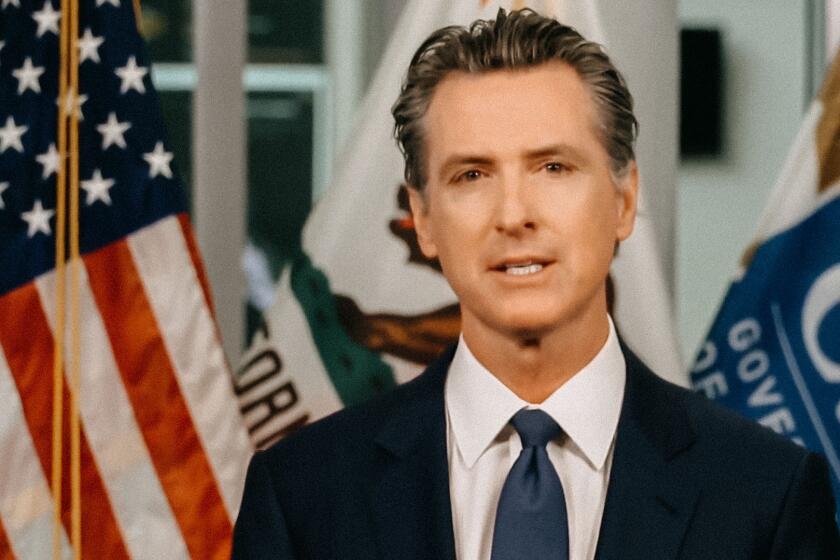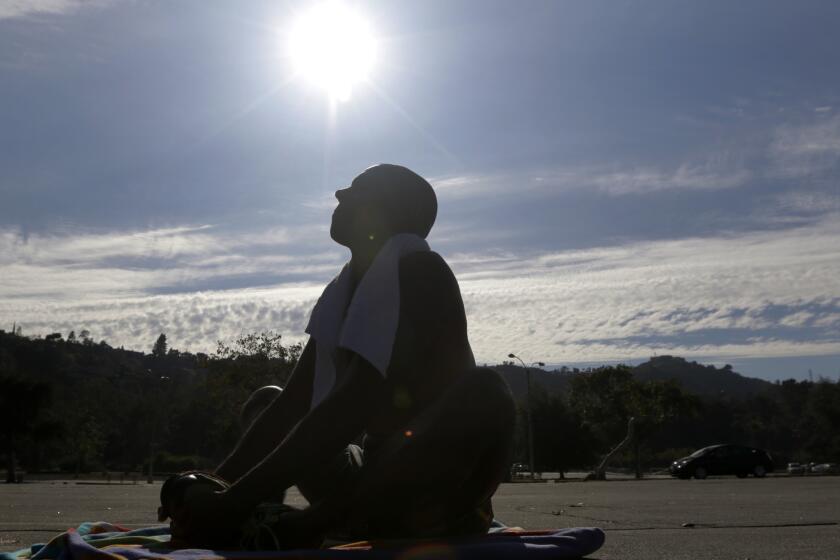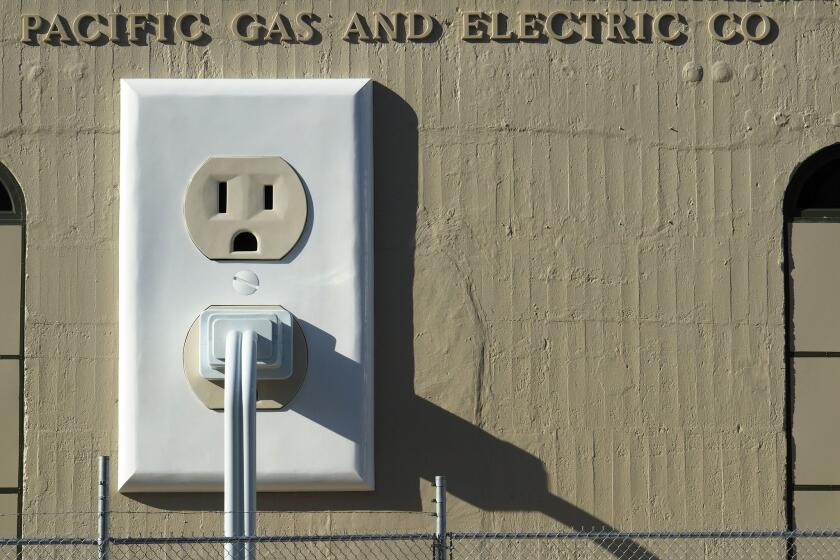California blackouts are Public Utilities Commission’s fault, grid operator says
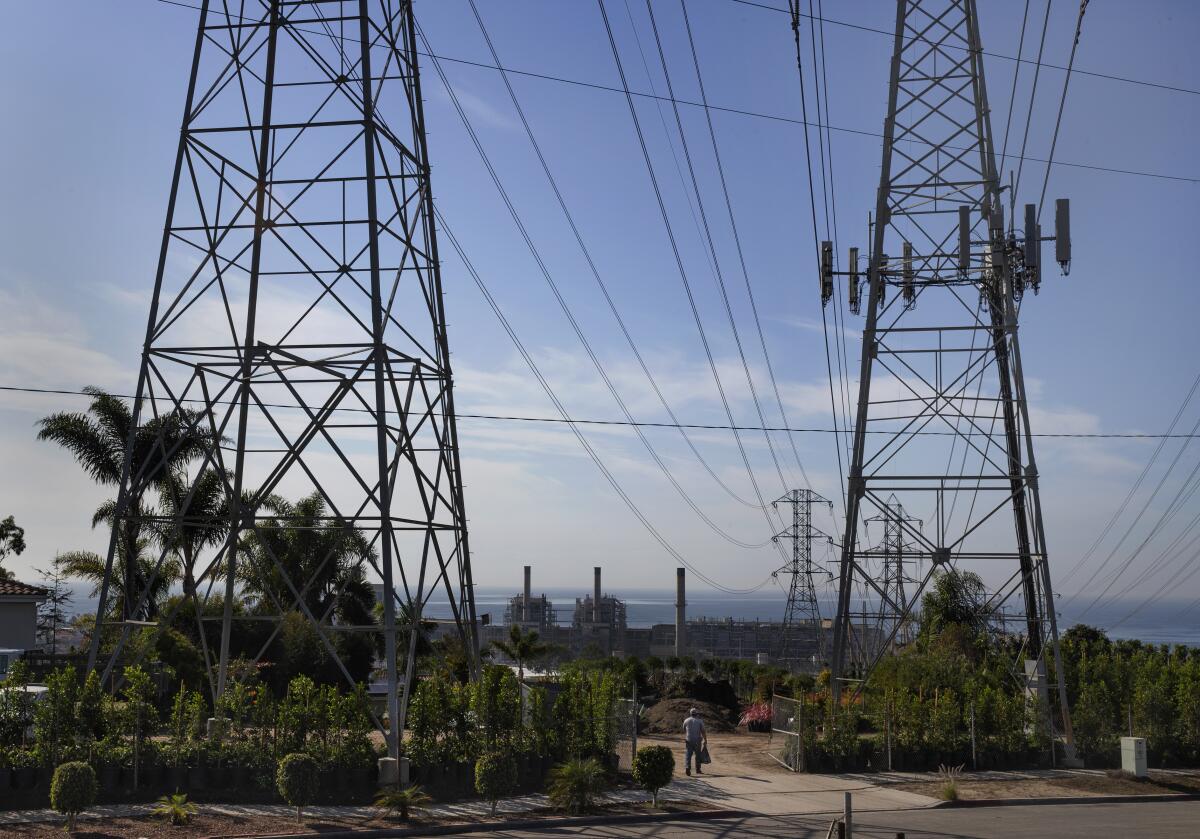
- Share via
California’s power grid operator delivered a blistering rebuke Monday to the state’s Public Utilities Commission, blaming the agency for rotating power outages — the first since the 2001 energy crisis — and warning of bigger blackouts to come.
In their first public comments since the blackouts began Friday evening, officials at the California Independent System Operator described a “perfect storm” of conditions that caused demand to exceed available supply: scorching temperatures in California and across the western United States, diminished output from renewable sources and fossil-fueled power plants affected by the weather, and in some cases plants going offline unexpectedly when electricity was needed most.
But Stephen Berberich, the grid operator’s president, said the state could have been prepared for that perfect storm if only the Public Utilities Commission had ordered utility companies to line up sufficient power supplies.
During the grid operator’s board meeting Monday, Berberich faulted the commission for failing to ensure adequate power capacity on hot summer evenings, when electricity from the state’s growing fleet of rooftop solar panels and sprawling solar farms rapidly drops to zero but demand for air conditioning remains high. It’s a challenge that will only intensify as California adds more solar panels and wind turbines to meet its targets of 60% renewable electricity by 2030 and 100% emissions-free power by 2045.
“For many years, we have pointed out to the [Public Utilities Commission] that there was inadequate power available during the net peak,” Berberich said, referring to the evening period when solar production dries up but cooling demand remains high. “The situation we are in could have been avoided.”
He added, “It’s near certain that we will be forced to ask the utilities to cut off power to millions today to balance supply and demand — today, tomorrow and perhaps beyond.”
Your guide to our clean energy future
Get our Boiling Point newsletter for the latest on the power sector, water wars and more — and what they mean for California.
You may occasionally receive promotional content from the Los Angeles Times.
Asked about the grid operator’s criticism, commission spokeswoman Terrie Prosper said the agency is “working with our sister agencies to better understand why this occurred.”
“The question we’re tackling is why certain resources were not available,” she said in an email.
Blackouts were ultimately avoided Monday evening, with the grid operator crediting lower-than-expected temperatures and energy conservation by homes and businesses. But additional outages could still come later in the week.
Customers of Southern California Edison, Pacific Gas & Electric and San Diego Gas & Electric had their power briefly shut off Friday and Saturday. Several municipal electric utilities that operate their own systems have not been affected, including the Los Angeles Department of Water and Power, which has been able to share excess power with the rest of the state.
Extreme weather across California has spurred fire tornadoes, rare lightning storms, record heat and rolling blackouts.
Even before this week’s heat wave, which saw temperatures reach a record-shattering 130 degrees in Death Valley, California’s power system was in flux.
So much solar power is generated during the afternoon that California sometimes pays other states to take its excess supply. But there are fewer gas-fired power plants than in past years to pick up the slack each evening. And coal plants have been shutting down across the West because of competition from cheaper natural gas and renewables, meaning there may be less energy available for California to import in a pinch.
All of those changes are manageable, experts say. Several studies have shown that running a large power grid using mostly renewable energy is technically possible and could save money because solar and wind power have gotten so cheap.
“We’re moving forward with a low-carbon grid,” Mary Leslie, a member of the Independent System Operator’s board of governors, said during Monday’s meeting. “I think the direction is really clear, and we’re not going backward. We’re going to move forward.”
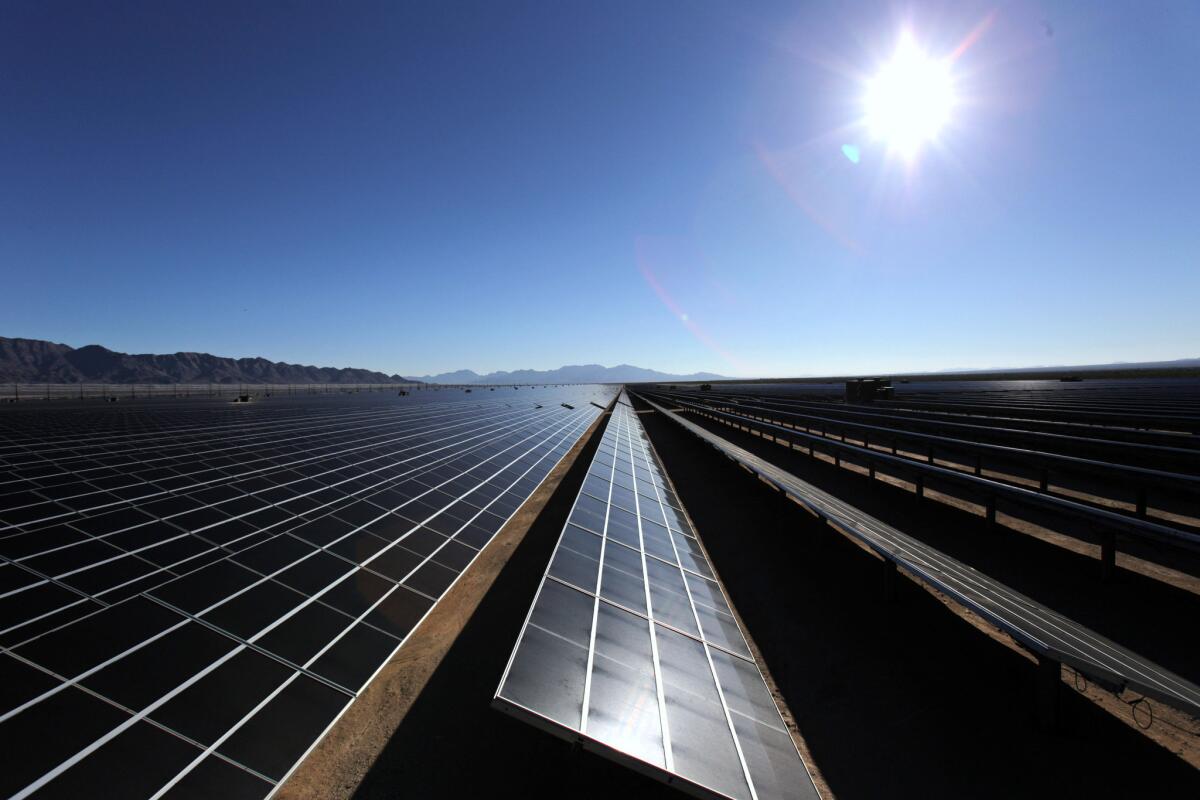
But this week’s energy emergency dramatizes the urgency of filling the evening gap.
Last year the Public Utilities Commission ordered Edison, PG&E and other utilities to buy thousands of megawatts of new power capacity. Most if not all of those resources are expected to be four-hour lithium-ion batteries that can store solar energy during the afternoon and distribute it when the sun goes down.
But none of those batteries are online yet — and the need will only grow when the massive Diablo Canyon nuclear power plant begins shutting down in 2024.
Jim Caldwell, a former assistant general manager at the Los Angeles Department of Water and Power, said the Public Utilities Commission should be acting much more aggressively to bring new supplies online. He echoed the grid operator’s call to look beyond batteries, and to build enough additional solar power to keep those batteries charged.
“Knowing what we know and where we’re going as a state, knowing that we’re going to need a lot of investments in renewables in order to meet the climate goals, what the hell’s going on?” Caldwell asked. “We know it’s cheaper, we can get the [federal] tax credits now. We ... need the economic activity.”
Your support helps us deliver the news that matters most. Subscribe to the Los Angeles Times.
The Independent System Operator, which runs the power grid for most of the state, warned in September that California could face evening power shortages as early as summer 2020, with much larger shortfalls coming in later years as several Los Angeles-area coastal gas plants retire. One of the system operator’s top officials said at the time that the summer 2020 gap could probably be resolved by importing power from other states, “as long as it’s not hot across the West.”
But this week, it is extremely hot across the West, with Las Vegas, Los Angeles, Phoenix, Sacramento and Seattle all breaking daily temperature records Sunday, and high temperatures expected to continue for several more days.
Coupled with stay-at-home orders necessitated by the COVID-19 pandemic, the heat wave could be even deadlier than usual for people stuck at home without air conditioning — a dynamic that may be worsened by California’s rotating power outages.
In this week’s Boiling Point newsletter, we’re talking fossil fuel divestment, the California coastline and Joshua trees.
Officials at the Independent System Operator described a mad dash to secure any available power supplies and reduce demand. Berberich said utilities in the Pacific Northwest have agreed to export some excess electricity to California, and the Department of Defense and other major energy users have agreed to consume less during peak periods.
The U.S. Bureau of Reclamation warned over the weekend that it was releasing emergency flows through Glen Canyon Dam on the Utah-Arizona border in part to generate more electricity for California, and that boaters on the Colorado River should prepare for rapid changes in river flow.
Utility companies, meanwhile, could do little except ask their customers to conserve power as much as they could from 3 p.m. to 10 p.m., when electricity demand is typically highest. On Sunday, the Independent System Operator preemptively called a “flex alert” for every day through Wednesday.
“It’s 3 pm. That means it’s time to set the thermostat to 78°, avoid using large appliances, and turn off unnecessary” lights, Southern California Edison tweeted Monday afternoon, linking to a page with more detailed advice on saving energy.
Although the rotating blackouts have been disruptive, they’re not wildly outside the realm of what power grid operators typically consider acceptable — at least so far.
It would be exorbitantly expensive to build enough power plants to ensure the electricity never goes off — and some of those plants might sit idle for years at a time. So instead, the U.S. utility industry has long followed a standard of having enough power on call to ensure this type of outage doesn’t happen more than once every 10 years.
The last time California was forced to implement rotating blackouts because of insufficient energy supply was nearly 20 years ago, during the 2001 energy crisis, as opposed to more recent intentional outages because of fire safety.
But these blackouts may strike a raw nerve for many PG&E customers after the utility’s decision last year to shut down power to millions of people in an effort to prevent its aging and poorly maintained transmission lines from igniting wildfires.
Wildfire-prevention outages by PG&E and Southern California Edison have thrown the reliability of the power grid into doubt.
In a letter to his own top energy officials Monday, Gov. Gavin Newsom described the blackouts as “unacceptable and unbefitting of the nation’s largest and most innovative state.” He instructed them to investigate what had gone wrong and take several steps to better prepare for future heat waves.
“Energy service shutoffs are simply too disruptive, and we must do more to prevent them in the future,” Newsom wrote.

Berberich said the Independent System Operator accepted responsibility for failing to give Californians more notice about the power supply emergency before rolling blackouts began this weekend.
“We thought there would be adequate power to supply the demand. We were wrong,” he said.
Not everyone accepted the Independent System Operator’s explanation for what’s going wrong on the grid.
Loretta Lynch, who served as president of the Public Utilities Commission during California’s early-2000s energy crisis, said she suspects but can’t yet prove that this week’s power supply shortages are a result of collusion among energy marketers — the same type of illegal activity that forced California to implement rolling blackouts two decades ago. She blamed the Independent System Operator for a history of failing to penalize power-plant owners who game the system to jack up prices.
“Their job one is to manage the damn grid, and they couldn’t do it,” Lynch said.
Berberich disagreed with that assessment, saying he’s seen no evidence that plant owners are withholding electricity.

